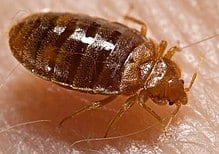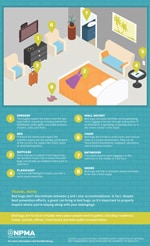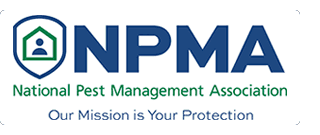BED BUGS
Bed bugs are parasitic insects that feed exclusively on blood. Cimex lectularius, the common bed bug, is the best known as it prefers to feed on human blood. The name bed bug derives from their preferred habitat: warm houses and especially near or inside beds and bedding or other sleep areas.
About Bed Bugs
Bed bugs are small parasitic insects, roughly the size of an apple seed. These insects are elusive, preferring to spend most of their time hiding in undisturbed areas. Bed bugs are well known to be “hitch-hikers” and are often carried unnoticed by their hosts to infest new locations.

Cimex lectularius (image credit: NPMA)
Because of their elusive nature, one of the first signs of a bed bug infestation are the actual bed bug bites people suffer, leaving one to wonder “What do bed bugs look like?”
Adult bed bugs are light to reddish-brown, flattened, oval shaped, and have no developed wings. Preferring to feed on human blood, these insects get their name from their preferred habitat. Bed bugs are mainly active at night and are capable of feeding unnoticed on their hosts.
Bed bugs have six life stages (five immature and one adult stage). They will shed their skins through multiple stages of their life cycle. The discarded outer shells look like clear, empty exoskeletons of the bugs themselves and are often one of the early signs of an infestation. Bed bugs must take a blood meal before molting to the next stage. An adult bed bug may have fed on you or your family as many as 6 times.
Female bed bugs lay about five eggs daily throughout their adult lives in a sheltered location such as mattress seams, crevices in box springs, spaces under baseboards, etc. Bed bug eggs hatch in about 4-12 days. Adult bed bugs live 6-12 months. Bed bugs can survive a wide range of temperatures. Bed bugs will die after 15 minutes of exposure to -32°C (-26°F) and all stages of life are killed by 15 minutes of exposure to 46°C (115°F).
Because of the fact that bed bugs are capable of surviving for extended periods of time without feeding, they can be a difficult pest to manage.
Health Risks of Bed Bugs
Bed bugs can cause a number of health effects including skin rashes, psychological effects, and allergic symptoms. No study has clearly found that the insect is able to transmit disease to a human being.
Bed bug bites may range from no visible effects to prominent blisters. Treatment involves the elimination of the insect but is otherwise symptomatic.
Bed bug populations are rapidly increasing. Additional research is needed to determine the reasons for the resurgence, the potential for bed bugs to transmit disease, and their impact on public health.
Bringing home a mattress from the street or discarded furniture, is unfortunately a common source of introducing bedbugs into a home. Finding a few bedbugs is not a reason to immediately dispose of your mattress. Chances are it is treatable. Call us to inspect. Also, the bedbugs may not only be in your mattress and throwing it away may give you a false sense of relief that you rid yourself of the problem.
For your protection and peace of mind, we offer “mattress covers” which prevent bedbugs from nesting in your mattress. If you had a bedbug problem you’d be wise to get one – and for the box spring if you have one. Reach out to us for information. We can help. Or you can buy directly here
• Bedbug treatment in Manhattan…
• Bedbug treatment in NYC area…
• Bedbugs certified removal…we have a Certified Bedbug Specialist on staff.

 Preventing and Getting Rid of Bed Bugs Safely
Preventing and Getting Rid of Bed Bugs Safely Bedbug Infographic – NPMA
Bedbug Infographic – NPMA NYC Quality of Life FAQ
NYC Quality of Life FAQ
